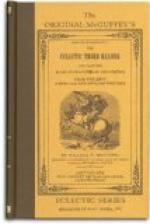mar’riage fer’ri age vag’a bond age herb’age her’mit age dis ad van’tage wharf’age pat’ron age es’pi on age
Lesson 149.
The suffix al signifies relating to; an signifies pertaining to; ant and ent, in many instances, signify the agent or doer.
tid’al com’ic al me dic’i nal ur’ban pub’li can di oc’e san claim’ant as sist’ant i tin’er ant a’gent pres’i dent cor re spond’ent
Able and ible signify that may be, capable of being, fit or worthy to be, or capacity.
eat’a ble blam’a ble am’i ca ble sal’a ble laugh’a ble nav’i ga ble leg’i ble for’ci ble com bus’ti ble cred’i ble au’di ble in del’i ble
Lesson 150.
Ist, ster, ee, and ess, generally signify the person
who, or thing which.
The last is an affix denoting the feminine gender.
aur’ist phys’i cist pi a’nist tap’ster chor’is ter for’est er grant ee’ mort ga gee’ as sign ee’ em’press shep’herd ess mar’chion ess
Dom signifies the office of or state of being; hood, the state of being; ish, somewhat, like; and ism, the condition or doctrines of.
king’dom chris’ten dom hea’then dom child’hood maid’en hood live’li hood knav’ish yel’low ish a’gu ish Bud’dhism Meth’od ism Mor’mon ism
Lesson 151.
Eer or ier generally signifies one who has charge of; en means made of, or, with adjectives, to make; ic signifies pertaining to, belonging to, or like; and ise or ize, to make, to become, or to assimilate.
cash ier’ fin an cier’ gon do lier’ cloth’ier en gi neer’ can non eer’ beech’en be hold’en em bold’en bright’en en light’en en liv’en civ’ic ce phal’ic me tal’lic u’til ize cat’e chise crit’i cise sat’ir ize civ’il ize os’tra cize
Lesson 152.
Ion and ment denote the state of being, or the act of; fy, to make or become; ance or ence, the act or state of; ive, having a tendency to, or the power or nature of; ory, the power or nature of, or belonging to; and ous, partaking of, or full of.
dis per’sion di ver’sion as per’sion ex cep’tion e lec’tion con di’tion a tone’ment a gree’ment dec’re ment de’i fy stu’pe fy sat’is fy an noy’ance ac cord’ance con cord’ance oc cur’rence ab hor’rence in dul’gence a mu’sive con clu’sive of fen’sive cur’so ry ar’mo ry man’da to ry dan’ger ous li’bel ous har mo’ni ous
Lesson 153.
Kin, ling, let, and ule indicate smallness or diminution.
lamb’kin man’i kin la’dy kin duck’ling un’der ling fos’ter ling leaf’let riv’u let flag’eo let glob’ule mol’e cule an i mal’cule
Some means like or same, full of, or very; ward denotes in the direction of; ure means state of; and y, full of, or composed of.




